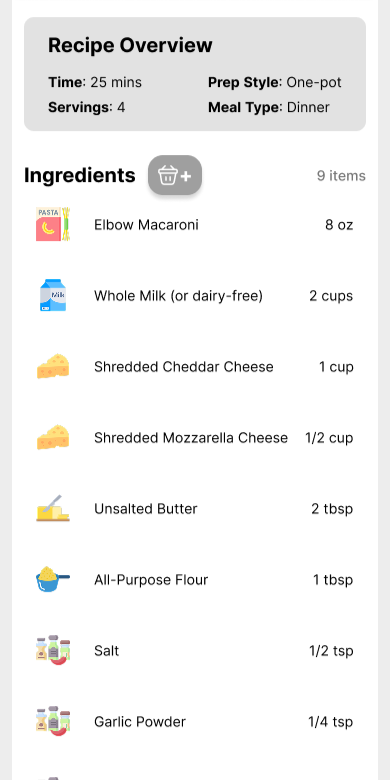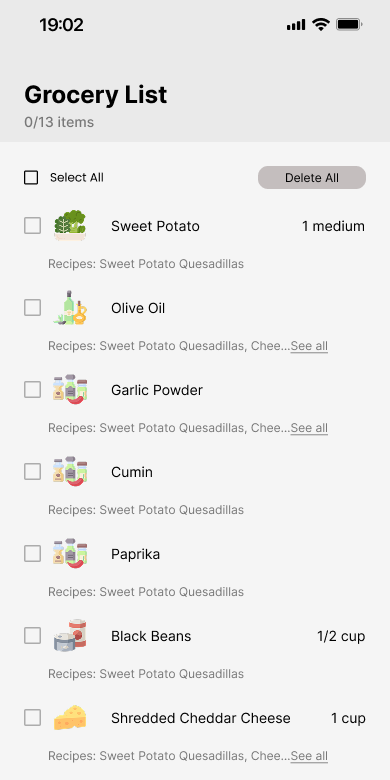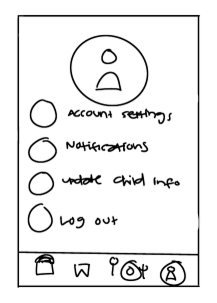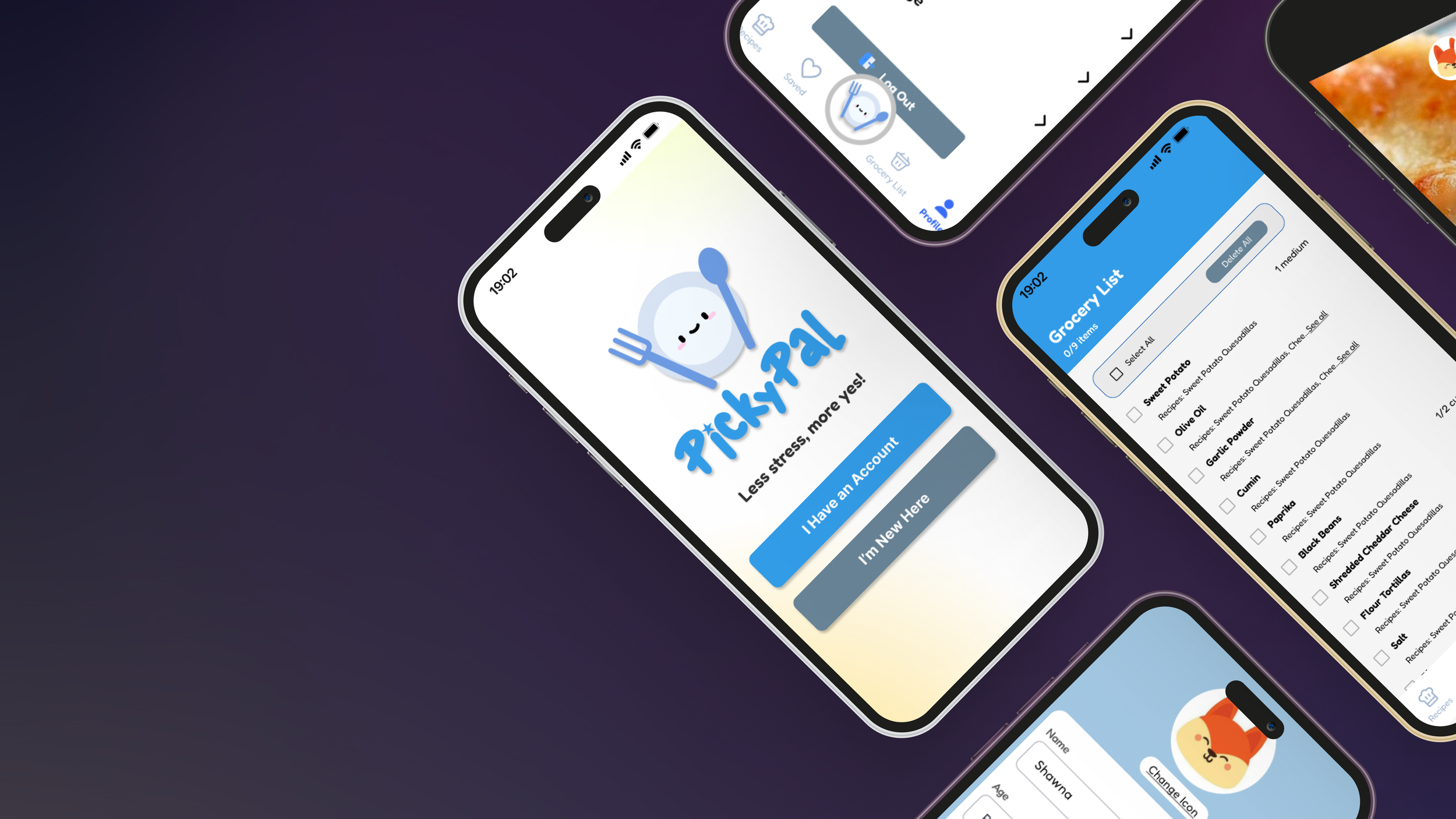a meal planner for parents to create kid-friendly, picky-proof recipes.
Create and personalize kid-friendly meal plans that fit picky tastes and dietary needs.
Project type: End-to-end mobile app design and branding
Role: Sole UX/UI designer
Industry: Food & Nutrition
Tools: Figma and FigJam
Duration: Q2-Q3 2025
Note: This is a personal UX project created for educational purposes and is not affiliated with any existing company or product.
Introduction
Potential Feature Benefits
-
Users can browse, swipe, and save recipes, making it easier to plan meals quickly without stress.
-
The app tailors recipe suggestions to a child’s preferences, dislikes, and dietary needs, helping caregivers find meals that actually work for their family.
-
Ingredients from selected recipes can be automatically added to a grocery list, streamlining shopping and reducing meal prep time.
-
Interactive features like swiping to explore and saving favorites keep users engaged and make meal planning more enjoyable.
-
By providing recipes that match children’s tastes and dietary needs, PickyPal helps caregivers reduce frustration and create more enjoyable mealtimes.
Project Overview
Planning meals for children can be challenging, especially when accommodating picky eaters’ preferences, dislikes, and dietary needs. Caregivers often struggle to find recipes that satisfy both nutrition and taste, leading to stressful mealtimes. PickyPal addresses this gap by offering a personalized, intuitive way to plan meals, making it easier to create enjoyable, balanced meals that children actually want to eat.
Who We’re Designing For
Planning meals for children can be challenging, especially when accommodating picky eaters’ preferences, dislikes, and dietary needs. PickyPal addresses this by offering a personalized, intuitive way to plan meals, helping caregivers create balanced, enjoyable meals with less stress. The app is designed for caregivers of young children (ages 25–40) who juggle busy schedules while managing selective eating habits, valuing tools that simplify meal planning and ensure nutrition. While targeted at this audience, PickyPal’s features can benefit anyone caring for children with picky eating tendencies.
PickyPal helps users plan meals for children by offering a variety of intuitive tools, making meal planning efficient, personalized, and stress-free:
Browse or swipe through recipes to explore options quickly.
Save favorite recipes for easy access later.
Automatically add ingredients to a grocery list, streamlining shopping and meal prep.
- 38 year old parent“Every meal feels like a battle, my kid refuses to eat anything I make.”
“It’s so hard to find new recipes that fit everyone’s diets without feeling repetitive.”
- 27 year old adult- 32 year old parent“I barely have time to cook, let alone figure out what everyone will actually eat.”
Research
Research Objectives
The goal of this research was to understand how caregivers plan meals for children, focusing on challenges related to picky eating, dietary needs, and meal preferences. The research explored how users select, organize, and save recipes, and what features could make meal planning easier and more efficient. It also examined pain points in existing methods to identify opportunities for improvement.
Research activities included:
User interviews (both in-person and virtual) with caregivers of young children
Exploration of frustrations in current meal planning habits and tools
Identification of opportunities to simplify and personalize the planning process
Notable Focus Points
-
Investigating what tools, apps, or methods caregivers currently use to plan meals, including recipe sources, meal kits, or online platforms, to understand gaps and opportunities for improvement.
-
Exploring strategies caregivers use to accommodate children’s food preferences and picky eating habits, and how this impacts meal planning and recipe selection.
-
Understanding how caregivers navigate allergies, intolerances, or other dietary restrictions, and what features could support safe and efficient meal planning.
-
Learning about pain points and stressors in meal prep and planning, and uncovering opportunities for features that simplify or make the process more enjoyable.
After conducting user interviews with caregivers of young children, we categorized key findings to identify common challenges. Many participants expressed frustration with meal planning, particularly when accommodating picky eating, dietary restrictions, and allergies. Users found it difficult to track recipes and organize meals efficiently, often relying on scattered resources like online searches, printed recipes, or memory. Participants highlighted that planning meals that their children would actually eat is a frequent source of stress. Overall, caregivers desired tools that simplify meal planning, offer personalized recipe suggestions, and allow easy saving and organization of favorite meals to reduce daily mealtime friction.
Yummly
Analyzing Interview Transcripts
In-Depth Competitive Analysis using SWOT
To inform the design of PickyPal, I conducted a SWOT analysis of three leading meal-planning platforms, Yummly, Cookpad, and Mealime, to identify strengths, weaknesses, and opportunities for improvement.
Key findings included:
Yummly excels in AI-driven personalization but lacks child-focused customization.
Cookpad promotes community engagement but offers limited filtering for picky eaters.
Mealime supports structured planning but doesn’t address nuanced dietary needs for kids.
These insights revealed an opportunity to design a tool centered on kid-friendly customization, ingredient exclusion, and allergy-safe meal planning, bridging gaps in existing platforms.
Mapping the Caregiver Experience
To better understand caregivers’ meal planning journeys, I created a detailed customer journey map outlining each stage, from discovering and selecting recipes to preparing meals and gathering feedback from their child. Each step captured user actions, touchpoints, goals, expectations, and emotional highs and lows, visualized through expressive icons and smiley markers.
This process revealed how emotions fluctuate throughout the experience—moments of excitement during recipe discovery often gave way to stress during grocery shopping or mealtime struggles. By identifying both pain points and moments of delight, I was able to design solutions that simplify decision-making, reduce stress, and help caregivers feel more confident and supported throughout the entire meal planning process.
Cookpad
Mealime
Define
Establishing Structure and Defining the Experience
To create a practical and user-friendly experience, I took an iterative approach, continuously refining PickyPal based on caregivers’ feedback. I focused on understanding how users choose, organize, and track meals for children with varying preferences and dietary needs. By developing personas, user flows, and user journeys, I was able to map the most efficient ways for caregivers to plan meals, save recipes, and manage grocery lists. This process ensured PickyPal delivers a streamlined, intuitive, and stress-reducing meal planning experience.
User Personas
Sitemap
When designing PickyPal, I created a sitemap to define the user journey and overall app structure. The flow begins with login or sign-up, leading to onboarding and then the homepage, the central hub of the experience.
From the homepage, users can access four main sections:
Discover Meals: Initially included multiple categories, later simplified to scroll/search and swipe browsing for variety and efficiency.
Grocery List: Refined to display ingredients and linked recipes; sharing options postponed for future updates.
Saved Meals: Focuses on saved favorites only, while the AI reduces repeat or dismissed meals for a cleaner experience.
Profile: Keeps child info, notifications, and account settings consistent with PickyPal’s family-centered purpose.
Persona 1: The Explorer Caregiver
Focused on expanding a child’s palate
Seeks ways to introduce new foods enjoyably
Values variety, balance, and positive mealtime experiences
Persona 2: The Practical Planner
Manages a picky eater’s preferences and dislikes
Prioritizes meals their child will eat
Balances nutrition, convenience, and reduced mealtime stress
User Flows
Designing user flows was essential for creating an intuitive and efficient experience in PickyPal. The two initial flows I focused on were:
Logging into the app and accessing the main dashboard
Saving a recipe and automatically generating a grocery list
Design
Designing the App Experience from the Ground Up
Designing PickyPal from the ground up allowed me to create an experience that feels bright, friendly, and approachable, reflecting the app’s goal of making mealtime easier and more enjoyable for caregivers and kids. I focused on simple navigation, intuitive recipe discovery, and seamless grocery management, refining interactions like scrolling, swiping, and saving to minimize friction.
Wireframes
I explored multiple layout variations through low- and mid-fidelity wireframes, refining key interactions like browsing, swiping, and saving meals. After testing and iterations, I finalized high-fidelity designs that delivered a cohesive, intuitive, and mobile-first meal planning experience.
Lo-Fi Wireframes
Mid-Fi Wireframes
Hi-Fi Wireframes
Branding, Logo, and Typography
PickyPal’s branding features a playful yet calming blue palette that balances vibrant baby blues with neutral, grounding tones. This combination creates a friendly, energetic, and child-like feel while maintaining trust, clarity, and reassurance for caregivers.
The PickyPal logo, a smiling plate with a fork and spoon, embodies the app’s playful, welcoming spirit and reinforces its food-focused purpose. Paired with the rounded, whimsical Shooting Star font, the branding feels joyful and child-centric, reflecting the app’s mission to make meal planning fun and stress-free.
PickyPal uses Fredoka, a soft, rounded typeface that enhances its warm, approachable personality. Its smooth curves keep the design kid-friendly yet readable, striking a balance between playful and practical to support a joyful, easy meal planning experience.
Test
Usability Testing & Prototyping
Prototype for Mobile (Tasks #1-5)
I conducted task-based usability testing with caregivers using a mobile prototype of PickyPal. Participants were asked to complete key tasks such as browsing recipes, saving meals, and generating grocery lists, while thinking aloud to share their thoughts and frustrations. I observed their interactions, stepping in only if they encountered significant difficulties, to better understand pain points, usability issues, and opportunities for improvement.
To validate PickyPal’s design, I conducted usability testing with a high-fidelity mobile prototype. Caregivers were observed as they explored recipes, saved favorite meals, and added ingredients to grocery lists, revealing where the experience was smooth and where it needed improvement. Insights from these sessions guided adjustments to navigation, feature layout, and interaction flow, resulting in a more intuitive, efficient, and user-friendly meal planning app.
Key Performance Benchmarks for Task Completion
-
Target Completion Time: < 1.5 min
Error Allowance: 0–1
User Confidence (1–10): 7–8
-
Target Completion Time: < 30 sec
Error Allowance: 0–1
User Confidence (1–10): 7–8
-
Target Completion Time: < 20 sec
Error Allowance: 0–1
User Confidence (1–10): 7–8
-
Target Completion Time: < 20 sec
Error Allowance: 0–1
User Confidence (1–10): 7–8
-
Target Completion Time: < 20 sec
Error Allowance: 0–1
User Confidence (1–10): 7–8
Testing Methods and Execution
Measuring Usability & Success Metrics
Testing showed that PickyPal’s main features were easy to navigate and highly user-friendly. Participants consistently rated the experience between 9 and 10 for ease of use, with 10 being the highest score. Users completed all tasks well within the target times without encountering errors, demonstrating that the app enables quick, efficient, and stress-free meal planning.
While no major usability issues were observed, participants suggested several opportunities for future improvements. One caregiver noted that some button interactions could provide clearer feedback, which can be refined in upcoming iterations. Another participant highlighted that adding the ability to adjust ingredient quantities per child would make meal planning even more accurate. Users also expressed interest in grouping items in the grocery list by category and exploring additional personalization options for recipe recommendations. These insights provide a roadmap for enhancing PickyPal’s functionality and overall user experience in future updates.
Iterations
Most of the design remained consistent, with only minor adjustments made to enhance the current usability and polish the interface. Refinements included improving button feedback and optimizing transition times between screens, which helped make interactions feel smoother and more responsive. While these changes improved the cosmetic and functional quality of existing features, larger potential iterations, such as integrating a more advanced grocery list management system or adding customizable meal planning templates, were identified but deferred for future versions due to time constraints. This approach allowed the prototype to remain focused and functional while still acknowledging opportunities for growth in later releases.
Conclusion
This project provided valuable insights into designing a user-centered meal planning experience for caregivers. While the current prototype effectively supports browsing, saving recipes, and generating grocery lists, usability testing revealed opportunities for refinement and future exploration. For upcoming iterations, I plan to explore enhancements such as streamlining navigation further, improving visual feedback for interactions, and experimenting with adaptive features that respond to caregiver preferences and usage patterns. Feedback also highlighted potential avenues like customizing recipe recommendations based on past behavior, adding in-app guidance for new users, and refining transitions to make the app feel more responsive. Overall, this project deepened my understanding of designing for accessibility and inclusivity, ensuring that meal planning feels approachable for all kinds of families. I also learned the value of iteration, seeing how even small design refinements can make a big difference in usability and user satisfaction.



































